Analyzing Instructional Design's Influence on Curriculum Theory
VerifiedAdded on 2022/08/14
|5
|1080
|9
Essay
AI Summary
This essay delves into the impact of instructional design on curriculum theory, examining how the integration of instructional design principles has influenced the selection of diverse content in classrooms. It traces the historical context of curriculum reform, highlighting the shift from traditional curriculum design to the incorporation of instructional design, driven by changes in the educational landscape and technological advancements. The essay analyzes how instructional design empowers teachers by providing tools for analyzing requirements, designing course objectives, and effectively selecting and utilizing multimedia resources. Furthermore, it addresses the critical question of responsibility for curriculum design, emphasizing the importance of a systematic approach to content development and delivery. Ultimately, the essay concludes that instructional design enhances teachers' ability to think systematically and apply varied media in classroom instruction.
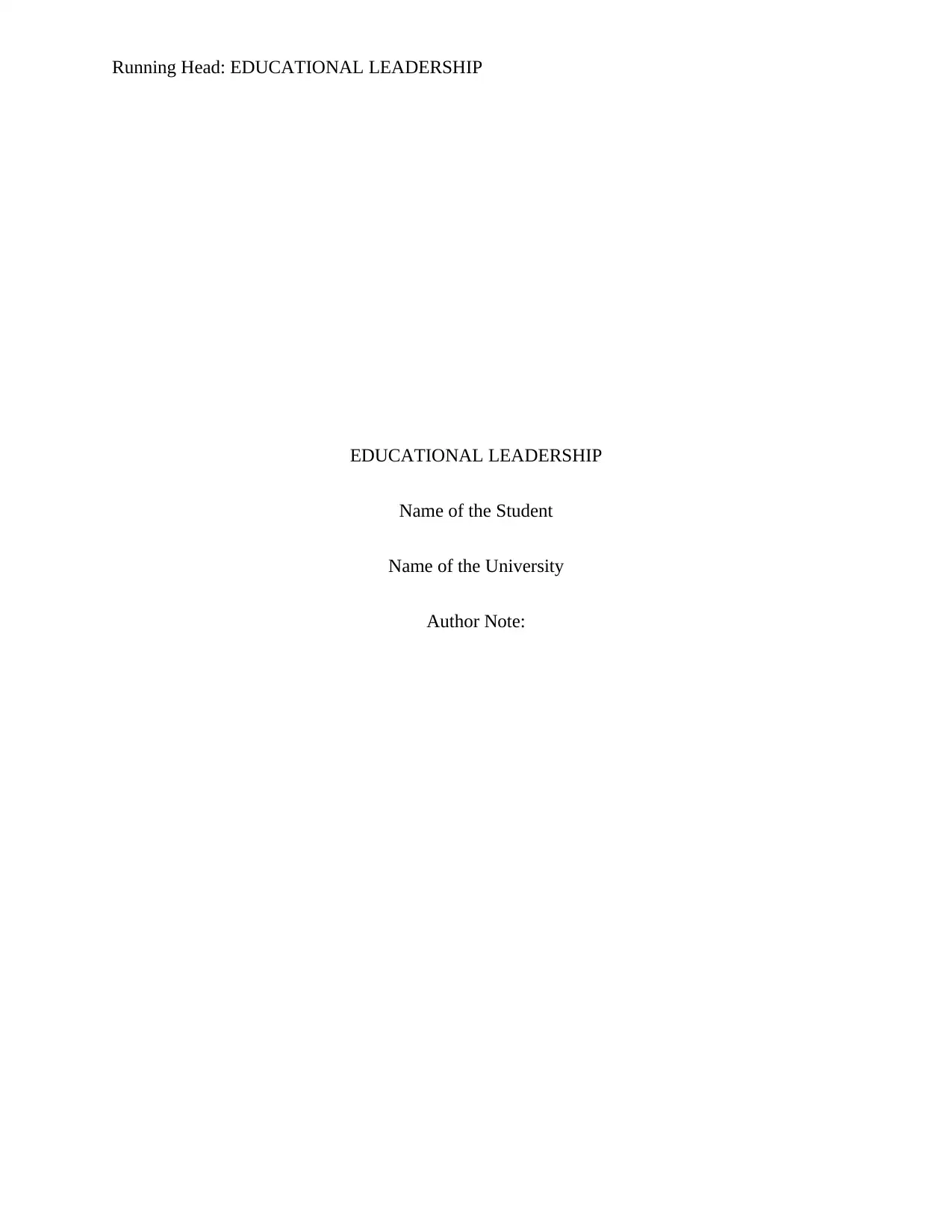
Running Head: EDUCATIONAL LEADERSHIP
EDUCATIONAL LEADERSHIP
Name of the Student
Name of the University
Author Note:
EDUCATIONAL LEADERSHIP
Name of the Student
Name of the University
Author Note:
Paraphrase This Document
Need a fresh take? Get an instant paraphrase of this document with our AI Paraphraser
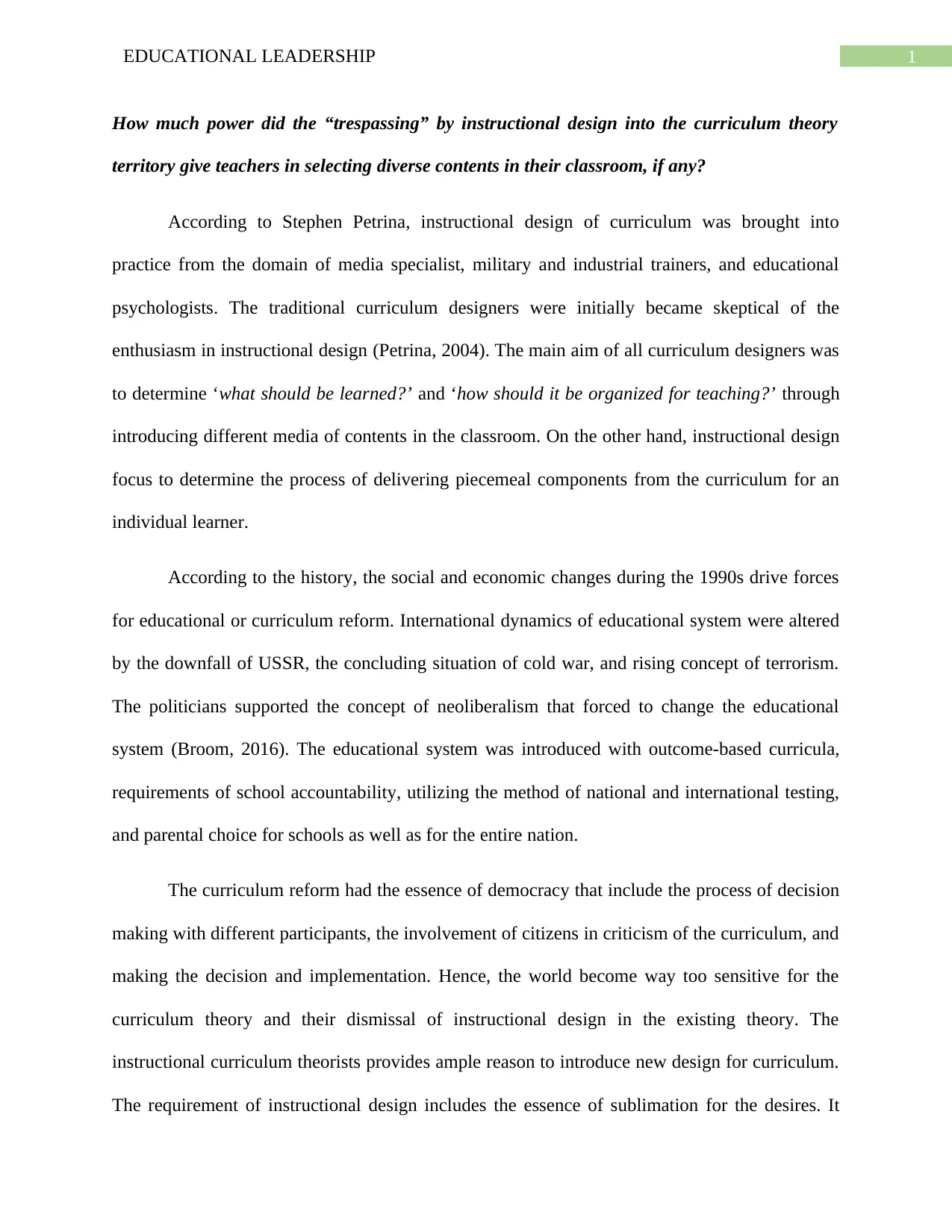
1EDUCATIONAL LEADERSHIP
How much power did the “trespassing” by instructional design into the curriculum theory
territory give teachers in selecting diverse contents in their classroom, if any?
According to Stephen Petrina, instructional design of curriculum was brought into
practice from the domain of media specialist, military and industrial trainers, and educational
psychologists. The traditional curriculum designers were initially became skeptical of the
enthusiasm in instructional design (Petrina, 2004). The main aim of all curriculum designers was
to determine ‘what should be learned?’ and ‘how should it be organized for teaching?’ through
introducing different media of contents in the classroom. On the other hand, instructional design
focus to determine the process of delivering piecemeal components from the curriculum for an
individual learner.
According to the history, the social and economic changes during the 1990s drive forces
for educational or curriculum reform. International dynamics of educational system were altered
by the downfall of USSR, the concluding situation of cold war, and rising concept of terrorism.
The politicians supported the concept of neoliberalism that forced to change the educational
system (Broom, 2016). The educational system was introduced with outcome-based curricula,
requirements of school accountability, utilizing the method of national and international testing,
and parental choice for schools as well as for the entire nation.
The curriculum reform had the essence of democracy that include the process of decision
making with different participants, the involvement of citizens in criticism of the curriculum, and
making the decision and implementation. Hence, the world become way too sensitive for the
curriculum theory and their dismissal of instructional design in the existing theory. The
instructional curriculum theorists provides ample reason to introduce new design for curriculum.
The requirement of instructional design includes the essence of sublimation for the desires. It
How much power did the “trespassing” by instructional design into the curriculum theory
territory give teachers in selecting diverse contents in their classroom, if any?
According to Stephen Petrina, instructional design of curriculum was brought into
practice from the domain of media specialist, military and industrial trainers, and educational
psychologists. The traditional curriculum designers were initially became skeptical of the
enthusiasm in instructional design (Petrina, 2004). The main aim of all curriculum designers was
to determine ‘what should be learned?’ and ‘how should it be organized for teaching?’ through
introducing different media of contents in the classroom. On the other hand, instructional design
focus to determine the process of delivering piecemeal components from the curriculum for an
individual learner.
According to the history, the social and economic changes during the 1990s drive forces
for educational or curriculum reform. International dynamics of educational system were altered
by the downfall of USSR, the concluding situation of cold war, and rising concept of terrorism.
The politicians supported the concept of neoliberalism that forced to change the educational
system (Broom, 2016). The educational system was introduced with outcome-based curricula,
requirements of school accountability, utilizing the method of national and international testing,
and parental choice for schools as well as for the entire nation.
The curriculum reform had the essence of democracy that include the process of decision
making with different participants, the involvement of citizens in criticism of the curriculum, and
making the decision and implementation. Hence, the world become way too sensitive for the
curriculum theory and their dismissal of instructional design in the existing theory. The
instructional curriculum theorists provides ample reason to introduce new design for curriculum.
The requirement of instructional design includes the essence of sublimation for the desires. It
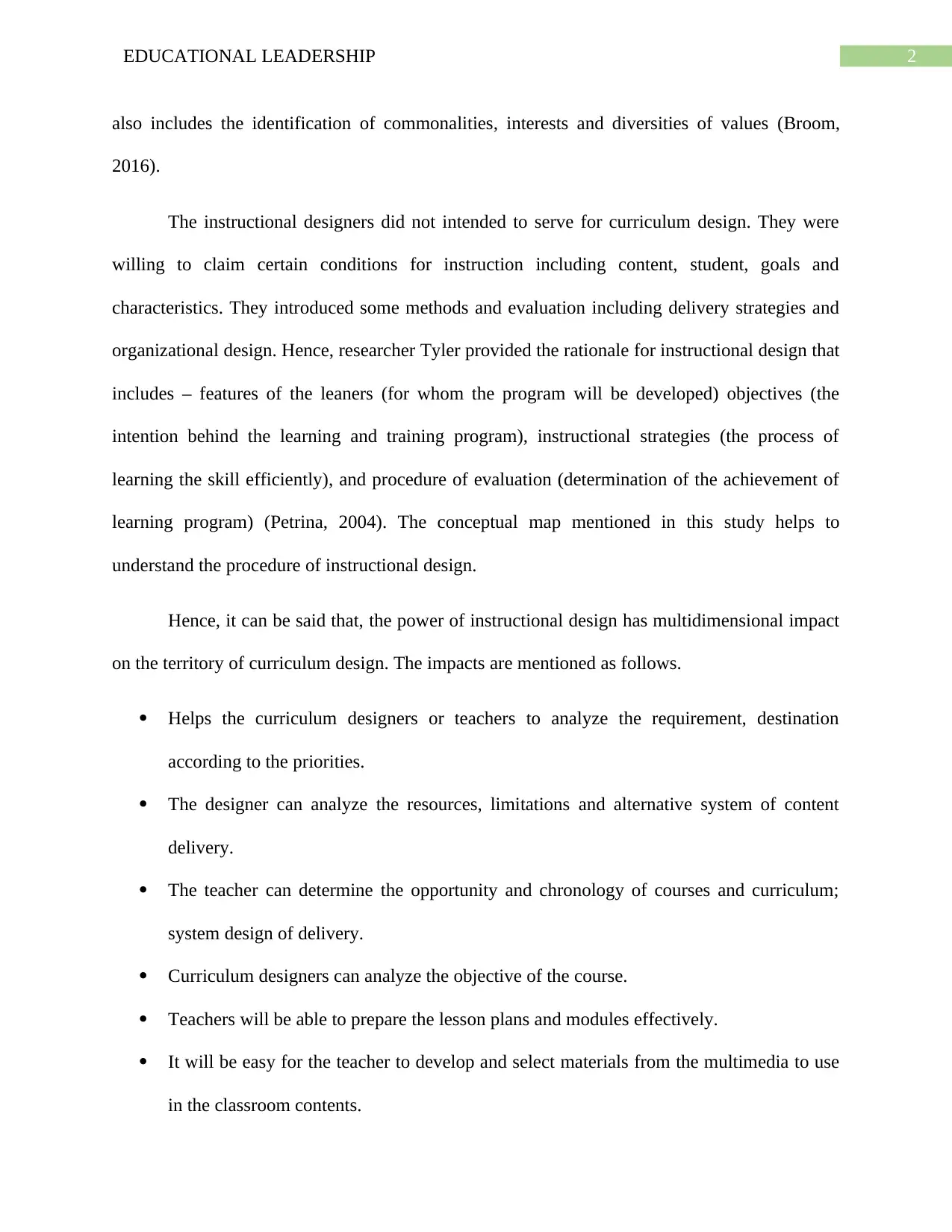
2EDUCATIONAL LEADERSHIP
also includes the identification of commonalities, interests and diversities of values (Broom,
2016).
The instructional designers did not intended to serve for curriculum design. They were
willing to claim certain conditions for instruction including content, student, goals and
characteristics. They introduced some methods and evaluation including delivery strategies and
organizational design. Hence, researcher Tyler provided the rationale for instructional design that
includes – features of the leaners (for whom the program will be developed) objectives (the
intention behind the learning and training program), instructional strategies (the process of
learning the skill efficiently), and procedure of evaluation (determination of the achievement of
learning program) (Petrina, 2004). The conceptual map mentioned in this study helps to
understand the procedure of instructional design.
Hence, it can be said that, the power of instructional design has multidimensional impact
on the territory of curriculum design. The impacts are mentioned as follows.
Helps the curriculum designers or teachers to analyze the requirement, destination
according to the priorities.
The designer can analyze the resources, limitations and alternative system of content
delivery.
The teacher can determine the opportunity and chronology of courses and curriculum;
system design of delivery.
Curriculum designers can analyze the objective of the course.
Teachers will be able to prepare the lesson plans and modules effectively.
It will be easy for the teacher to develop and select materials from the multimedia to use
in the classroom contents.
also includes the identification of commonalities, interests and diversities of values (Broom,
2016).
The instructional designers did not intended to serve for curriculum design. They were
willing to claim certain conditions for instruction including content, student, goals and
characteristics. They introduced some methods and evaluation including delivery strategies and
organizational design. Hence, researcher Tyler provided the rationale for instructional design that
includes – features of the leaners (for whom the program will be developed) objectives (the
intention behind the learning and training program), instructional strategies (the process of
learning the skill efficiently), and procedure of evaluation (determination of the achievement of
learning program) (Petrina, 2004). The conceptual map mentioned in this study helps to
understand the procedure of instructional design.
Hence, it can be said that, the power of instructional design has multidimensional impact
on the territory of curriculum design. The impacts are mentioned as follows.
Helps the curriculum designers or teachers to analyze the requirement, destination
according to the priorities.
The designer can analyze the resources, limitations and alternative system of content
delivery.
The teacher can determine the opportunity and chronology of courses and curriculum;
system design of delivery.
Curriculum designers can analyze the objective of the course.
Teachers will be able to prepare the lesson plans and modules effectively.
It will be easy for the teacher to develop and select materials from the multimedia to use
in the classroom contents.
⊘ This is a preview!⊘
Do you want full access?
Subscribe today to unlock all pages.

Trusted by 1+ million students worldwide
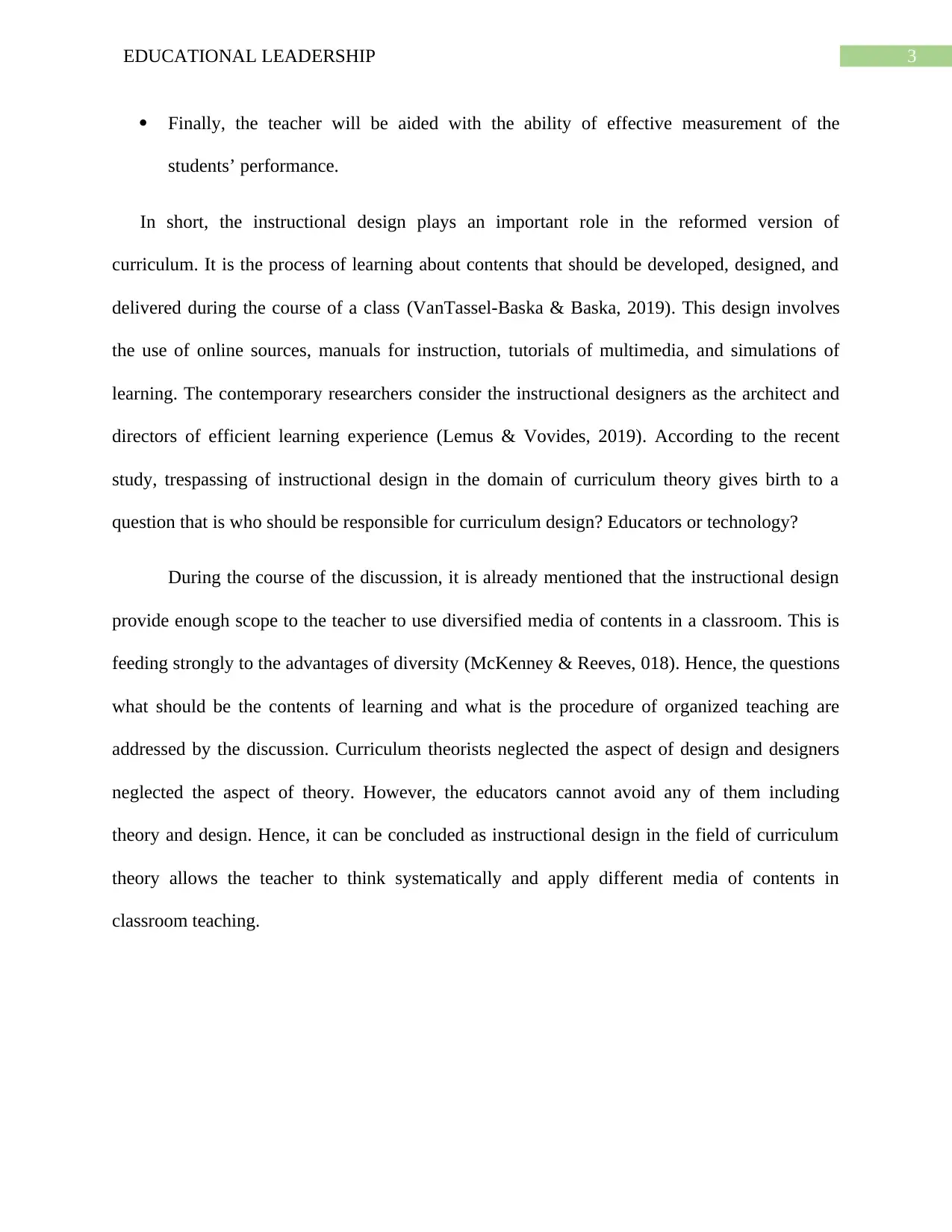
3EDUCATIONAL LEADERSHIP
Finally, the teacher will be aided with the ability of effective measurement of the
students’ performance.
In short, the instructional design plays an important role in the reformed version of
curriculum. It is the process of learning about contents that should be developed, designed, and
delivered during the course of a class (VanTassel-Baska & Baska, 2019). This design involves
the use of online sources, manuals for instruction, tutorials of multimedia, and simulations of
learning. The contemporary researchers consider the instructional designers as the architect and
directors of efficient learning experience (Lemus & Vovides, 2019). According to the recent
study, trespassing of instructional design in the domain of curriculum theory gives birth to a
question that is who should be responsible for curriculum design? Educators or technology?
During the course of the discussion, it is already mentioned that the instructional design
provide enough scope to the teacher to use diversified media of contents in a classroom. This is
feeding strongly to the advantages of diversity (McKenney & Reeves, 018). Hence, the questions
what should be the contents of learning and what is the procedure of organized teaching are
addressed by the discussion. Curriculum theorists neglected the aspect of design and designers
neglected the aspect of theory. However, the educators cannot avoid any of them including
theory and design. Hence, it can be concluded as instructional design in the field of curriculum
theory allows the teacher to think systematically and apply different media of contents in
classroom teaching.
Finally, the teacher will be aided with the ability of effective measurement of the
students’ performance.
In short, the instructional design plays an important role in the reformed version of
curriculum. It is the process of learning about contents that should be developed, designed, and
delivered during the course of a class (VanTassel-Baska & Baska, 2019). This design involves
the use of online sources, manuals for instruction, tutorials of multimedia, and simulations of
learning. The contemporary researchers consider the instructional designers as the architect and
directors of efficient learning experience (Lemus & Vovides, 2019). According to the recent
study, trespassing of instructional design in the domain of curriculum theory gives birth to a
question that is who should be responsible for curriculum design? Educators or technology?
During the course of the discussion, it is already mentioned that the instructional design
provide enough scope to the teacher to use diversified media of contents in a classroom. This is
feeding strongly to the advantages of diversity (McKenney & Reeves, 018). Hence, the questions
what should be the contents of learning and what is the procedure of organized teaching are
addressed by the discussion. Curriculum theorists neglected the aspect of design and designers
neglected the aspect of theory. However, the educators cannot avoid any of them including
theory and design. Hence, it can be concluded as instructional design in the field of curriculum
theory allows the teacher to think systematically and apply different media of contents in
classroom teaching.
Paraphrase This Document
Need a fresh take? Get an instant paraphrase of this document with our AI Paraphraser
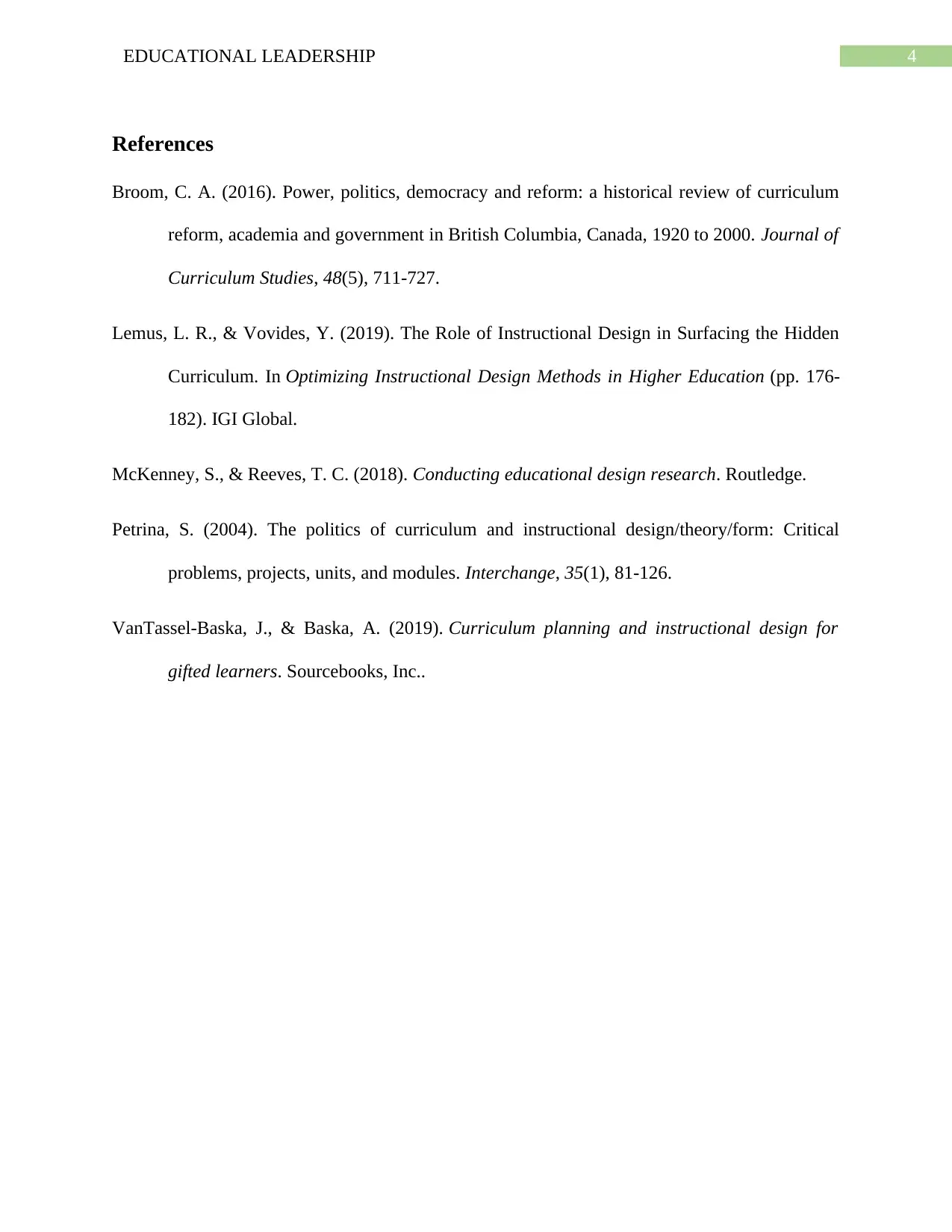
4EDUCATIONAL LEADERSHIP
References
Broom, C. A. (2016). Power, politics, democracy and reform: a historical review of curriculum
reform, academia and government in British Columbia, Canada, 1920 to 2000. Journal of
Curriculum Studies, 48(5), 711-727.
Lemus, L. R., & Vovides, Y. (2019). The Role of Instructional Design in Surfacing the Hidden
Curriculum. In Optimizing Instructional Design Methods in Higher Education (pp. 176-
182). IGI Global.
McKenney, S., & Reeves, T. C. (2018). Conducting educational design research. Routledge.
Petrina, S. (2004). The politics of curriculum and instructional design/theory/form: Critical
problems, projects, units, and modules. Interchange, 35(1), 81-126.
VanTassel-Baska, J., & Baska, A. (2019). Curriculum planning and instructional design for
gifted learners. Sourcebooks, Inc..
References
Broom, C. A. (2016). Power, politics, democracy and reform: a historical review of curriculum
reform, academia and government in British Columbia, Canada, 1920 to 2000. Journal of
Curriculum Studies, 48(5), 711-727.
Lemus, L. R., & Vovides, Y. (2019). The Role of Instructional Design in Surfacing the Hidden
Curriculum. In Optimizing Instructional Design Methods in Higher Education (pp. 176-
182). IGI Global.
McKenney, S., & Reeves, T. C. (2018). Conducting educational design research. Routledge.
Petrina, S. (2004). The politics of curriculum and instructional design/theory/form: Critical
problems, projects, units, and modules. Interchange, 35(1), 81-126.
VanTassel-Baska, J., & Baska, A. (2019). Curriculum planning and instructional design for
gifted learners. Sourcebooks, Inc..
1 out of 5
Related Documents
Your All-in-One AI-Powered Toolkit for Academic Success.
+13062052269
info@desklib.com
Available 24*7 on WhatsApp / Email
![[object Object]](/_next/static/media/star-bottom.7253800d.svg)
Unlock your academic potential
Copyright © 2020–2025 A2Z Services. All Rights Reserved. Developed and managed by ZUCOL.





